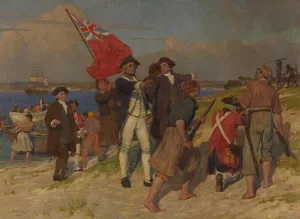From Australia’s Jewish Past:
Emanuel Phillips Fox
impressionist painter and teacher
First published in J-Wire November 22, 2022

Emanuel Phillips Fox was born on 12 March 1865 at Fitzroy, Melbourne, the seventh child of Alexander Fox, a Jewish photographer from London, and his Sydney-born wife Rosette, née Phillips.
Emanuel matriculated from school aged fifteen and took drawing lessons from John Carter a Melbourne artist. Between 1878 and 1886 he trained at the National Gallery Schools under the direction of a number of well-known Melbourne art teachers. Emanuel did well in his art studies and won awards for landscape painting at the gallery students’ exhibitions in 1884 and 1886.
In February 1887 Emanuel left for Europe. He studied in Paris at the Académie Julian, in Gérôme’s atelier at the Ecole des Beaux-Arts, and with the American artist Thomas Alexander Harrison. In the summer of that year he painted in plein air artists’ communities at Etaples and in Brittany and visited Giverny. In 1890 he settled at St Ives in Cornwall, one of the key centres of plein air painting in England, and the following year lived in Madrid where he copied Velasquez’ works. These contacts modified his French training.
Emanuel returned to Melbourne in October 1892 and joined the Victorian Artists’ Society where he was a vocal council member and exhibitor between 1893 and 1900. He launched one-man shows in 1892 and 1900-01, contributed to major displays in Sydney, Adelaide, and Bendigo, and was represented in the Australian Exhibition at the Grafton Galleries in London in 1898. Although his art was held in esteem, patronage was largely confined to portraits.
In 1893 Emanuel and Albert Tucker established the Melbourne School of Art, where students were introduced to French academic practices at its summer outdoor school, at a property known as Charterisville, near Eaglemont. He taught plein air painting, incorporating some aspects of Impressionist practice. This school was closely associated with the Heidelberg School of Australian Art and was known as the most vital art school in Melbourne in the 1890s.

In 1900 the trustees of the National Gallery commissioned Emanuel to paint ‘The Landing of Captain Cook at Botany Bay’ through the William Gillbee bequest which provided a young artist with the sum of one thousand pounds and the opportunity to paint overseas. The recipient was to paint a picture of Australian historical interest. He subsequently left Melbourne in March 1901, travelled to Paris, staying at St Ives, and then moved on to London where his time was spent creating the masterpiece – The Landing of Captain Cook at Botany Bay, 1770.
He exhibited at the Royal Academy from 1903, having previously shown there in 1895, and sent works elsewhere in Britain.
On 9 May 1905 in Ealing, London, Emanuel married Ethel Carrick and they settled in Paris until 1913, travelling widely in Europe and northern Africa during this time. These were fertile years in Fox’s career, and his art celebrated a way of life that was leisured and elegant. From 1890 he contributed works to the ‘’Old Salon’’, and in 1894 won a gold medal with his portrait ‘My Cousin’. In 1906 he began exhibiting at the ‘’New Salon’’ and elsewhere. He became a member of the International Society of Sculptors, Painters and Gravers, an associate of the Société Nationale des Beaux-Arts in 1907 and its sociétaire in 1910.
Emanuel and his wife visited Australia in 1908 and 1913, exhibiting and painting in Melbourne, Sydney, and Adelaide. The outbreak of war brought them back to Melbourne from a trip to Tahiti, and in 1915 they helped to organize an art union in aid of war funds and the French Red Cross.
A modest painter by European standards, Emanuel is among Australia’s most gifted colourists and figure painters. He was celebrated for his painting of sunlight effects and he combined Impressionist-oriented vision with academic training. Apart from portraits and landscapes he mainly painted elegant female figures and family groups. His repertoire extended to market and Arab scenes and rural subjects. He is represented in the National Gallery of Australia, all State and various regional galleries, and the Louvre, Paris.
Emanuel was an unassuming and reserved person. He did not have strong leadership qualities and this perhaps prevented him from exerting as powerful an influence as did Tom Roberts and later Max Meldrum. However, his use of colour, led artists of the younger generation to further experiment.
On 8 October 1915 Emanuel died of cancer in hospital at Fitzroy, and was buried in Brighton cemetery. His wife Ethel remained in Melbourne until 1916 and from there lived mainly in Europe, becoming quite a well-known artist herself, exhibiting across Britain, France, and Australia. She returned to Australia several times between 1925 and 1952, each time arranging exhibitions and painting in several of the cities and along the rivers of northern New South Wales.
Ethel passed away in a Melbourne hospital on 17 June 1952. Ethel and Emanuel had no children.
Acknowledgments
- Wikipedia
- Australian Dictionary
- Art Gallery of NSW
- Carrick Hill South Australia
